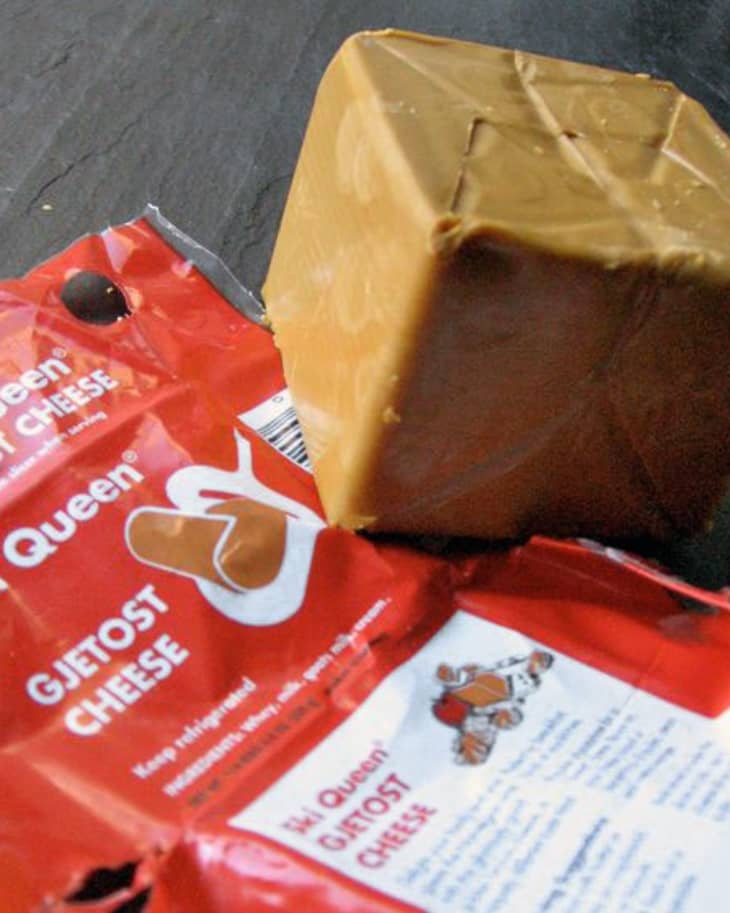The Closest Cheese to Fudge: Gjetost
Say it: “Yay-toast.” Have you tried this cheese?It’s Norwegian, and although the name translates directly to “goat cheese,” chances are that this cheese tastes just about as far from any you’ve had before. Gjetost is as sweet as caramel, with the texture of a dense, buttery fudge.
Until this week, I’d really only thought to use Gjetost as part of a dessert course. Its intensity kind of precludes it from being part of your arsenal of cheeses for snacking or for serving before a meal. And then I stumbled upon a recipe using it in fondue. Genius.
Gjetost is delicious on its own, don’t get me wrong. It is toothsome and rich, and lingers on the palate for miles, which must appeal to those Norwegian skiers, who pack it as a hearty snack on the slopes. (You may also hear it referred to as “ski cheese.”) You’ll be left smacking your lips, just trying to de-stick it from the roof of your mouth: it’s like the peanut butter of cheese. There’s the slightest hit of acidity at the finish, serving as reminder of its to the cheese family. This is seriously sweet stuff, due primarily to its make process.
Like ricotta, Gjetost comes from whey— that is, the liquid by-product of cheesemaking. But while ricotta is fresh, ready in a matter of minutes, Gjetost is a time-consuming process which requires slow and continuous heating of whey, cream, and milk. Over many hours, the milk sugars are cooked to the point of caramelization. In its solid state, Gjetost is a concentrated, sweet block that tastes more like butterscotch than like actual cheese. Pretty unique.
I’ve known about Gjetost for years, but it’s something I rarely purchase, not because I don’t like it— it’s kind of a novelty, I think, and a tasty one, at that— but because I don’t really know when or how to serve it. It’s pretty funny looking, and doesn’t make for the most elegant presentation. And so, when I stumbled upon a recipe for a gjetost fondue over at Food52, it nearly beckoned me and my skeptical sensibilities.
The process couldn’t be easier. Throw some sugar, cinnamon, and heavy cream into a fondue pot along with the gjetost and some cognac or vanilla stir away until smooth. And smooth, it gets. Just be careful not to overheat, and if you need additional thinning while eating, add heavy cream, a teaspoon at a time. You’ll have the closest thing to dolce de leche in cheese form.
It’s nearly perfect to make if you like trying new things. And if you’re of the population that hovers by the dessert fondue fountain at weddings, you’ll love this. The recipe suggests serving the fondue with bananas and pecans, but I could imagine it going nicely with apples, pears, dried apricots, and figs, or even with shortbread, biscotti, and a dessert wine or sherry, if you’re serving it after dinner.
And the more I whittle away at the block I have leftover from the fondue, the more I think those skiers must really be onto something, because at least from the warmth of my apartment, this cheese is pretty darned delicious. All by itself.
Get the recipe: Gjetost Fondue at Food52
Find it! Gjetost can be found in the dairy case at Whole Foods $6.50 for an 8.8 ounce block.
Nora Singley is an avid lover of cheese, and for some time she was a cheesemonger and the Director of Education at Murray’s Cheese Shop in New York City, where she continues to teach cheese classes for the public. She is currently an assistant TV chef on The Martha Stewart Show.
Related: Fondue: Tricks of the Trade
